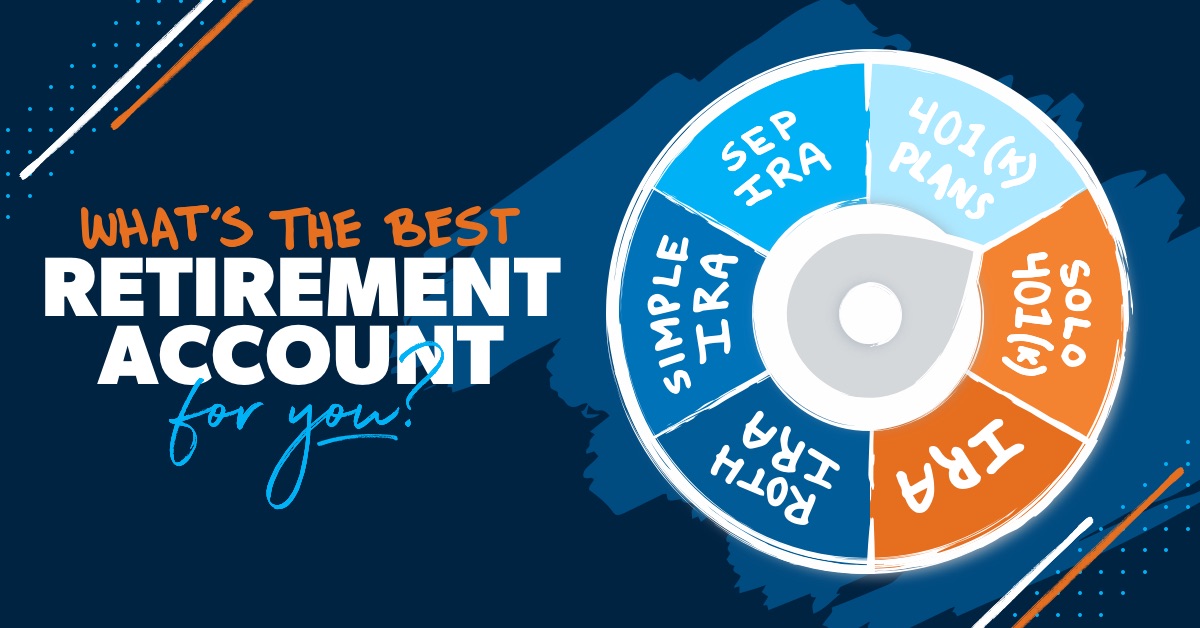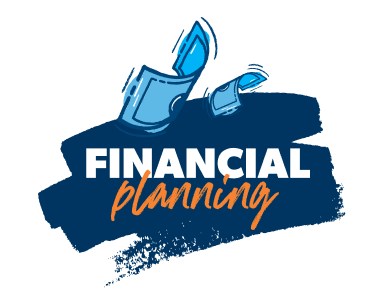Best Retirement Plans Of 2024: Which Account is Right for You?
15 Min Read | May 23, 2024

Trying to sort through all of your retirement account options can be a daunting task. You start hearing terms like 401(k) and 403(b) and IRA and all of a sudden you feel like you’re drowning in an alphabet soup of random numbers and letters all mashed together.
Look, we hear you! It’s a lot to process. But choosing the best retirement plans to hold your investments is a big deal. It could mean the difference between enjoying tax-free withdrawals in retirement or having to pay Uncle Sam every time you open up your nest egg. There’s a lot at stake here.
Here are the four main types of retirement accounts you need to know about:
- Employer-Sponsored Retirement Accounts
- Individual Retirement Accounts (IRAs)
- Taxable Investment Accounts
- Small Business and Self-Employed Retirement Accounts
How can you tell which retirement accounts are the right ones for you? Let’s find out!
1. Employer-Sponsored Retirement Accounts
If you’re like most working Americans, you probably have some sort of retirement plan available through the workplace. And many employers even pitch in to help you save for your retirement!
Let’s dive into some of the most common employer-sponsored retirement accounts out there, so you can figure out which plan works best for you.
401(k)
A 401(k) is a retirement account companies offer employees to help them save for retirement, and it’s the most common type of retirement plan in the workplace. Your 401(k) could contain any type of investment, but usually you’ll get to choose from a small selection of mutual funds your company’s plan offers.
There are two main types of 401(k)s—traditional or Roth—and the big difference between them is how they’re taxed:
- Traditional 401(k): These retirement plans are funded with pretax dollars and the money inside grows on a tax-deferred basis. That just means you won’t pay taxes on the money now, but you’ll be taxed on the withdrawals you take out in retirement.
- Roth 401(k): The money you put into a Roth 401(k) grows tax-free, and you won’t pay any taxes when you take the money out in retirement. But only your contributions grow tax-free. If your company offers to match the money you put in (more on that in a minute), the money your company puts in grows tax-deferred, so you’ll have to pay taxes on the match side of the account.
For 2024, you’re allowed to put up to $23,000 yearly into a 401(k). But if you’re age 50 or older and need to catch up, you can put up to $30,500 in your account. That’s slightly higher than the 2023 limits of $22,500 ($30,000 if you’re 50 or older).1
You get to choose how much money you want to contribute to the plan, either a percentage of your salary or a set dollar amount, and that money will be taken out of your paycheck automatically.
And many employers will offer a company match—that’s when your company offers to match a percentage of your retirement contributions in your 401(k). Translation? Free money!
One last thing you need to know about 401(k)s is that you can’t withdraw money from the account until you reach age 59 1/2.2 If you do decide to crack open your nest egg before then, the IRS will hit you with taxes and an early withdrawal penalty. So until then, leave that money alone!
403(b)
If you have a job at a nonprofit or tax-exempt organization—we're talking to teachers, government employees, and some nurses and doctors here—you might have a 403(b) plan instead of a 401(k).
A 403(b) and a 401(k) basically work the same way. They both have the same contribution limits, early withdrawal penalties, similar tax treatment, and 403(b)s can be either traditional or Roth accounts. So nearly everything we said about 401(k)s applies to the 403(b) too.
How much will you need for retirement? Find out with this free tool!
But there’s one thing with a 403(b) to be cautious about: the investment options. Sometimes these plans can be loaded with insurance products like annuities that have low returns and expensive fees and surrender charges. Steer clear of those and stick with good growth stock mutual funds!
Thrift Savings Plan (TSP)
The Thrift Savings Plan gives federal workers and members of the military the opportunity to invest in a tax-advantaged account for retirement. Just like a 401(k) or 403(b), TSP contributions (which can also be Roth or traditional, by the way) can be taken straight out of your paycheck.
Now, the TSP offers five different individual fund options for you to choose from, each one invested in either stock or bond index funds.
- The Government Securities Investment (G) Fund
- The Fixed Income Index Investment (F) Fund
- The Common Stock Index Investment (C) Fund
- The Small Capitalization Stock Index (S) Fund
- International Stock Index Investment (I) Fund
We recommend sticking with a mix of C, S and I Funds, with 80% invested in the C Fund, and 10% each going into the S & I Funds.
Pension Plans
Also known as defined benefit plans, pension plans use a formula based on your salary history and length of employment to calculate a guaranteed payout in retirement. With these types of plans, the risk is on the employer to save and invest the contributions. All you have to do is do your job and stay loyal to the company, and in exchange you get a gold watch and a pension check every month when you retire.
But that was back in the good ol’ days. Today, the pension is an endangered species—replaced by defined contribution plans like the 401(k) and 403(b) in most workplaces. Baby boomers, union members and public sector workers (government, police, teachers, etc.) make up the majority of pension-holders today.
The problem is that pensions aren’t always a safe bet. Some companies and governments scale back pension benefits because they’re in financial trouble or mismanaged their investments. That’s not right! And if you wanted to leave your company for a new job, you’ll still see some pension money in retirement but not as much as you originally expected.
So if you have a pension plan, just be careful—they’re not always a slam dunk. You might want to sit down with an investment professional regularly to figure out if your pension is going to be enough for your retirement future.
Just to recap, here are the pros and cons of going with an employer-sponsored retirement plan like a 401(k):
Employer-Sponsored Retirement Accounts
|
Pros |
Cons |
|
|
2. Individual Retirement Accounts (IRAs)
Individual Retirement Accounts (IRAs) are retirement savings accounts that allow you to save for retirement outside of your workplace retirement plan with some nice tax advantages.
While most workplace plans only let you choose from a handful of investment options, you can choose to have almost any kind of investment inside of your IRA, including mutual funds, annuities or even real estate.
There are two main types of IRAs for you to choose from: traditional IRAs and Roth IRAs. Here are some rules that apply to both types of accounts:
- In 2024, you can put up to $7,000 in your IRAs ($8,000 if you’re age 50 or older).
- You’ll pay an early withdrawal penalty on any of the growth you take out of an IRA before age 59 1/2.
- You can put money in at any age.3
But there are some major differences between traditional and Roth IRAs! Let’s take a closer look at both to see which one is the better choice for you.
Traditional IRAs
Traditional IRAs are invested with pretax contributions, which means you can claim them as tax deductions now, but you’ll have to pay taxes on the money you withdraw in retirement later. And you can’t keep the money parked in your traditional IRA forever—you have to start making withdrawals at age 73 (Uncle Sam wants his fair share).4
One of the nice things about traditional IRAs is there are no income limits on contributions, which means you can put money into your IRA no matter how much money you make!
Roth IRAs
We're going to come right out and say that we love Roth IRAs! Since they’re invested with after-tax dollars, that means the money you invest grows tax-free, and you won’t owe any taxes when you withdraw that money in retirement. And there are no required minimum withdrawals (RMDs), since you’ve already paid taxes on the money you put into a Roth IRA.
However, there are limits to how much you can contribute to your Roth IRA, based on your income. For 2024, those income limits are $240,000 for married couples filing jointly or $161,000 for single people.5
There is a way around that rule, and it’s called a backdoor Roth IRA. And don’t worry, it’s perfectly legal! Here’s how it works: First, you open up a traditional IRA or put money into one you already have. Then, as soon as that money is in your traditional IRA account, ask your investment pro to convert that IRA into a Roth IRA. When you do that, you’ll have to pay the taxes on that money, so make sure you have the cash on hand to pay what you owe!
Here's the good, the bad, and the (not so) ugly on IRAs:
Individual Retirement Accounts
|
Pros |
Cons |
|
|
3. Taxable Investment Accounts
Taxable investment accounts (like a brokerage account) offer something classic retirement plans like a 401(k) or an IRA don’t, and that’s flexibility.
First, there are no income limits—anyone with a couple hundred bucks and a pulse can open an account with a brokerage firm. And second, you can take money out of a taxable investment account at any time for any reason without getting slammed with early withdrawal penalties. That makes taxable investment accounts a great option if you’re looking for ways to retire early.
But hold the phone! There’s one huge drawback to using taxable investment accounts, which is that you’ll pay taxes on any money your account earns. That’s why you should only consider using taxable investment accounts for retirement after you’ve maxed out your tax-advantaged options like a 401(k) or an IRA.
If you’ve maxed out your 401(k) and IRA and still haven’t hit 15% of your gross income, or if you’re looking for someplace to invest beyond 15%, investing in good growth stock mutual funds inside a taxable investment account is a good option to help you hit that mark.
Taxable Investment Accounts
|
Pros |
Cons |
|
|
4. Small Businesses and Self-Employed Retirement Accounts
More and more Americans are working for themselves as contractors, freelancers and small business owners. Many others work for a small business that might not have the resources to offer a full-fledged 401(k) plan yet.
Just because you don’t have access to a 401(k) doesn’t mean you’re out of options. The good news is that you do have some options!
One-Participant 401(k)
If you’re self-employed and don't have any employees, a one-participant 401(k)—also known as a solo 401(k)—was designed with you in mind. You can contribute up to $23,000 in 2024 (or $30,500 if you’re age 50 or older), and those contributions are tax-deductible. Then, on top of that, you can put in an additional employer match—up to 25% of your income—as long as your total contributions are less than $69,000 per year.6
SIMPLE IRA
Once you start hiring employees to help you take your business to the next level, that changes things. Now it’s not just your retirement you have to worry about—you have to start thinking about how to help your employees save for retirement too. That’s a big deal! And a SIMPLE IRA can help with that.
A SIMPLE IRA is basically a start-up retirement savings plan for small businesses. This plan makes it easy for small business owners to save for their own retirement and contribute to their employees’ retirement savings as well.
In 2024, employees can save up to $16,000 in the plan (that’s up from $15,500 in 2023). Anyone age 50 and older can put in an extra $3,500 as a catch-up contribution.7
SEP-IRA
A simplified employee pension (SEP-IRA) is another retirement plan option for small business owners or self-employed individuals, offering many of the major tax advantages of a traditional IRA.
Unlike a SIMPLE IRA, which allows both employers and employees to contribute to the plan, only employers are allowed to contribute on behalf of their employees. For 2024, employers can put up to 25% of an employee’s salary into their account each year, up to a total contribution of $69,000.8
Small Business and Self-Employed Retirement Accounts
|
Pros |
Cons |
|
|
Which Retirement Accounts Are Best for You?
Honestly, the answer depends on your situation. An employee at a large company has different options than a freelance photographer. You’ll want to meet with an investment professional who can help you make the right decision.
But no matter who you are, you should be investing 15% of your gross income for retirement in good growth stock mutual funds (once you’re out of debt with a fully funded emergency fund).
A good rule of thumb to follow when trying to decide which retirement accounts are best for you and where to start is this: Match beats Roth beats traditional.
Here are our general guidelines for how to make the most of your retirement account options, especially if you have access to a workplace plan.
Step 1: Take Advantage of Your Company Match
Let’s start with the match. If you have an employer-based plan like a 401(k) at work with a company match, start by investing there up to the match.
Let’s say your company offers a 4% match. If you earn $60,000 a year and take advantage of your match, that’s an extra $2,400 a year being invested for retirement! Once you’re ready to start investing, the first thing you should do is invest in your 401(k) up to the company match. But do not count that employer match as part of your 15%—that match is just the cherry on top of your sundae.
If your company offers a Roth 401(k) option, that’s a deal too good to pass up. Take it! If you like your investment options in your Roth 401(k), you can simply invest your entire 15% there and you’re done.
What if you don’t have a company match at work? Then you’ll start investing with a Roth IRA first and max out that account before investing in your 401(k).
Step 2: Open Up a Roth IRA
Once you’ve invested up to the company match, it’s time to move on to the Roth IRA. Remember, the Roth IRA lets you enjoy tax-free growth and tax-free withdrawals in retirement. Don’t miss that!
If you’re a high-income earner, you might not be eligible to open up or contribute to a Roth IRA. That’s okay! You can go with a traditional IRA instead.
Step 3: Go Back to Your Workplace Plan
So, what happens if you invest up to the match, max out your Roth IRA, and still haven’t hit 15%? If that happens, you can go back to your workplace plan and bump up your contributions there until you hit 15%.
That’s it! Between your employer-sponsored plan—like a 401(k), 403(b) or TSP—and a Roth IRA, you should be able to save enough money for retirement while enjoying the tax benefits both accounts have to offer.
Work With an Investment Pro
Choosing your retirement accounts is a huge step that will help you get closer to turning your retirement dreams into a reality. And you don’t have to make these decisions on your own!
When you team up with a SmartVestor Pro, they can answer any questions you have and help you weigh the pros and cons of each account type so you can make informed decisions.
Make an Investment Plan With a Pro
SmartVestor shows you up to five investing professionals in your area for free. No commitments, no hidden fees.
This article provides general guidelines about investing topics. Your situation may be unique. To discuss a plan for your situation, connect with a SmartVestor Pro. Ramsey Solutions is a paid, non-client promoter of participating Pros.


